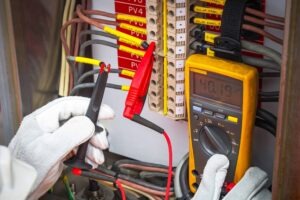In the United Kingdom, the safety and reliability of electrical services are of paramount importance. To ensure the well-being of individuals and protect properties, strict regulations are in place to govern the test and inspect (T&I) of electrical installations. This article will provide an overview of the testing and inspection requirements in the UK, highlighting the significance of compliance and the roles of professionals involved.
Safety Regulations and Legal Requirements: The T&I of electrical services in the UK are governed by various safety regulations and legal requirements. The key regulation is the Electricity at Work Regulations 1989, which places a legal duty on employers, employees, and self-employed individuals to ensure electrical systems are safe to use and maintained properly. Compliance with these regulations is essential for reducing the risk of electrical accidents, fires, and other hazards.
Test and Inspect Frequency
The frequency of inspections depends on the type of installation and the environment in which it operates. The Institution of Engineering and Technology (IET) publishes the “Wiring Regulations” (BS 7671), which provides detailed guidelines for inspection and testing frequencies. Additionally, different organizations, such as the Health and Safety Executive (HSE) and the National Inspection Council for Electrical Installation Contracting (NICEIC), offer further guidance and certification services.
Qualified Professionals: Ensuring the safety and compliance of electrical installations requires the expertise of qualified professionals. Electricians and electrical contractors play a vital role in T&I of electrical services. In the UK, electricians must be appropriately trained and hold relevant certifications, such as the City and Guilds 2391 qualification for T&I. Qualified electricians are knowledgeable about the regulations, standards, and best practices, enabling them to identify potential risks, rectify faults, and certify the safety of electrical installations.
Test and Inspect Types
Several types of T&I are carried out to verify the safety and compliance of electrical services. These include:
- Initial Verification: Performed during the installation process to ensure compliance with regulations and standards.
- Periodic Inspection: Conducted at regular intervals to assess the condition of existing electrical installations and identify any deterioration or potential hazards.
- Portable Appliance Testing (PAT): Involves inspecting and testing portable electrical equipment to ensure it is safe for use.
- Condition Reporting: Provides an in-depth assessment of the electrical installation’s condition, identifying any defects or areas of concern.
General Guidelines for T&I
In the UK, the test and inspection periods for different dwellings vary based on their type and usage. Here are the general guidelines:
- Domestic Dwellings (Owner-occupied houses, flats, etc.): Electrical installations in domestic dwellings should ideally be inspected and tested at least every 10 years or on change of occupancy, whichever comes first.
- Rented Properties (Houses, flats, etc.): For rented properties, electrical installations should be inspected and tested at intervals not exceeding 5 years or at each change of tenancy, whichever comes first. This is in compliance with the Electrical Safety Standards in the Private Rented Sector (England) Regulations 2020.
- Commercial Properties: Electrical installations in commercial properties should typically be inspected and tested at least every 5 years. However, the frequency may vary based on factors such as the nature of the business, the type of installation, and any specific requirements outlined in regulations or by insurance companies.
- Industrial Properties: Similar to commercial properties, electrical installations in industrial settings are generally inspected and tested every 5 years. However, again, this may vary depending on specific circumstances and regulatory requirements.
It’s important to note that these are general guidelines, and the specific requirements may vary based on factors such as the type of installation, the recommendations of a qualified electrician or electrical engineer, and any regulatory changes or local regulations. Additionally, regular checks and maintenance are recommended regardless of the prescribed inspection intervals to ensure ongoing safety and compliance.
Benefits
- Enhanced Safety: Identifying potential hazards and rectifying faults minimizes the risk of electrical accidents, shocks, and fires, safeguarding lives and properties.
- Compliance with Regulations: By adhering to the required testing and inspection standards, individuals and organizations comply with legal obligations, reducing liability and potential penalties.
- Increased Reliability: Thorough testing and inspection help identify issues before they escalate, reducing unexpected breakdowns and improving the reliability of electrical systems.
- Energy Efficiency: Optimized electrical installations result in improved energy efficiency, reducing wastage and lowering energy bills.
At JG Electrical Services Ltd, we recognize the critical importance of inspecting and testing electrical services in the UK.
Our qualified professionals ensure safety, compliance, and efficiency, showcasing our commitment to electrical safety and protecting individuals and properties.
FOR ANY ENQUIRIES, NO OBLIGATION QUOTE OR TO DISCUSS A PROJECT THEN
please click here to contact us

